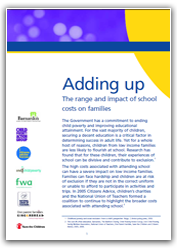Adding up

The range and impact of school costs on families
The Government has a commitment to ending child poverty and improving educational attainment. For the vast majority of children, securing a decent education is a critical factor in determining success in adult life. Yet for a whole host of reasons, children from low income families are less likely to flourish at school. Research has found that for these children, their experience of school can be divisive and contribute to exclusion.
The high costs associated with attending school can have a severe impact on low income families. Families can face hardship and children are at risk of exclusion if they are not in the correct uniform or unable to afford to participate in activities and trips. In 2005 Citizens Advice, children's charities and the National Union of Teachers formed a coalition to continue to highlight the broader costs associated with attending school.
In February 2007 a new Department for Education and Skills (DfES), now Department for Children, Schools and Families (DCSF), School Admissions Code came into force in England. For the first time the Code makes clear reference to the importance of limiting the costs of school uniform and trips. In Wales the Assembly Government consulted on new guidance on uniform policies in 2004, and will be issuing guidance to school governing bodies in late September 2007. this will provide advice on ways to reduce the cost of school uniform.
In June and July Citizens Advice undertook a survey of parents to find out whether schools' practices comply with the guidance as set out in the Code, and what further changes schools will need to make in order to comply. Overall, the findings suggest little compliance with the principles of the Code by the schools represented in the survey. The wide range of comments include both good practice as well as poor practice, highlighting a lack of consistency between schools.
This briefing argues that stronger enforcement responsibilities need to be placed on statutory bodies to ensure that children from low income families are not disadvantaged in school.
Key findings
School uniform
- Three quarters of parents of secondary school children and two-thirds of parents of primary school children found it difficult to meet the costs of school uniform.
- Of those respondents who needed to buy uniform items from a specialist supplier, almost nine out of ten parents of secondary school children and over half of parents of primary school children needed to purchase at least three items.
School trips
- Three quarters of parents of secondary school pupils and two thirds of parents of primary school pupils found it difficult to meet the cost of school trips.
- Only one in four parents thought it was clear that families on a low income could be exempt from some or all of the cost of the trip.
Other costs associated with schooling
- 71% of primary school respondents and 79% of secondary school respondents found it difficult to meet all of the costs discussed in the survey.
- For primary school, the top three items asked for were school photographs, non-school uniform days, and items for a jumble sale, raffle, or cake sale. For secondary school, the top three items were non-school uniform days, school photographs, and equipment for lessons.
The impact of cost
- Four out of five parents of secondary school pupils and over half of parents of primary school pupils were worried that their child would be disciplined as a result of not having the correct uniform.
- 58% of secondary school respondents and 55% of primary school respondents were also worried that their child would be bullied as a result of not having the correct uniform.
- Nearly one in ten indicated that costs associated with schooling had affected their choice of school.

